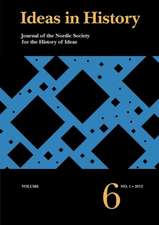From Viking Stronghold to Christian Kingdom: State Formation in Norway, c. 900-1350: Emersion: Emergent Village resources for communities of faith
Autor Sverre Baggeen Limba Engleză Hardback – 19 apr 2010
In this seminal work, Sverre Bagge provides a detailed account of Norwegian state formation in the period from c. 900 to 1350, widening his perspective to include a discussion of the emergence of the medieval state and state formation in the Middle Ages in general.The primary objective is to examine Norway as a case that may serve to illuminate some general problems of European state formation in the period, problems related both to the formation of the European system of independent kingdoms within a common cultural framework and to the inner development of these kingdoms. The volume furthermore examines the changes that took place in the military, social-economical, ideological, legal and administrative fields between the first formation of the kingdom and the early fourteenth century which, according to common opinion, represents a peak in the development of a Norwegian state. The volume constitutes a vivid and compelling feat, offering a fresh and innovative approach to an important chapter in the history of Norway, while also casting new light on developments in the larger context of European history.
Din seria Emersion: Emergent Village resources for communities of faith
-
 Preț: 144.99 lei
Preț: 144.99 lei -
 Preț: 133.99 lei
Preț: 133.99 lei - 9%
 Preț: 352.50 lei
Preț: 352.50 lei -
 Preț: 146.50 lei
Preț: 146.50 lei -
 Preț: 208.31 lei
Preț: 208.31 lei -
 Preț: 156.84 lei
Preț: 156.84 lei -
 Preț: 115.53 lei
Preț: 115.53 lei -
 Preț: 548.71 lei
Preț: 548.71 lei - 8%
 Preț: 346.31 lei
Preț: 346.31 lei - 8%
 Preț: 360.28 lei
Preț: 360.28 lei -
 Preț: 216.89 lei
Preț: 216.89 lei -
 Preț: 101.43 lei
Preț: 101.43 lei -
 Preț: 215.51 lei
Preț: 215.51 lei -
 Preț: 185.37 lei
Preț: 185.37 lei - 8%
 Preț: 563.24 lei
Preț: 563.24 lei -
 Preț: 179.04 lei
Preț: 179.04 lei -
 Preț: 106.35 lei
Preț: 106.35 lei -
 Preț: 138.81 lei
Preț: 138.81 lei -
 Preț: 273.93 lei
Preț: 273.93 lei -
 Preț: 128.11 lei
Preț: 128.11 lei - 9%
 Preț: 353.24 lei
Preț: 353.24 lei -
 Preț: 176.49 lei
Preț: 176.49 lei -
 Preț: 94.22 lei
Preț: 94.22 lei -
 Preț: 144.80 lei
Preț: 144.80 lei -
 Preț: 126.25 lei
Preț: 126.25 lei -
 Preț: 67.35 lei
Preț: 67.35 lei -
 Preț: 163.52 lei
Preț: 163.52 lei -
 Preț: 138.26 lei
Preț: 138.26 lei -
 Preț: 182.98 lei
Preț: 182.98 lei - 18%
 Preț: 2261.34 lei
Preț: 2261.34 lei -
 Preț: 279.55 lei
Preț: 279.55 lei -
 Preț: 115.82 lei
Preț: 115.82 lei -
 Preț: 208.54 lei
Preț: 208.54 lei -
 Preț: 167.85 lei
Preț: 167.85 lei -
 Preț: 160.63 lei
Preț: 160.63 lei -
 Preț: 183.89 lei
Preț: 183.89 lei - 9%
 Preț: 352.77 lei
Preț: 352.77 lei -
 Preț: 307.53 lei
Preț: 307.53 lei - 12%
 Preț: 290.56 lei
Preț: 290.56 lei - 8%
 Preț: 311.68 lei
Preț: 311.68 lei -
 Preț: 120.81 lei
Preț: 120.81 lei -
 Preț: 229.92 lei
Preț: 229.92 lei - 6%
 Preț: 324.95 lei
Preț: 324.95 lei -
 Preț: 145.41 lei
Preț: 145.41 lei -
 Preț: 125.41 lei
Preț: 125.41 lei -
 Preț: 147.26 lei
Preț: 147.26 lei - 18%
 Preț: 348.59 lei
Preț: 348.59 lei -
 Preț: 302.76 lei
Preț: 302.76 lei - 8%
 Preț: 564.99 lei
Preț: 564.99 lei
Preț: 502.35 lei
Preț vechi: 613.39 lei
-18% Nou
Puncte Express: 754
Preț estimativ în valută:
96.12€ • 100.63$ • 79.54£
96.12€ • 100.63$ • 79.54£
Carte disponibilă
Livrare economică 15-29 martie
Preluare comenzi: 021 569.72.76
Specificații
ISBN-13: 9788763507912
ISBN-10: 8763507919
Pagini: 441
Dimensiuni: 180 x 250 x 33 mm
Greutate: 1.07 kg
Editura: Museum Tusculanum Press
Colecția Museum Tusculanum Press
Seria Emersion: Emergent Village resources for communities of faith
ISBN-10: 8763507919
Pagini: 441
Dimensiuni: 180 x 250 x 33 mm
Greutate: 1.07 kg
Editura: Museum Tusculanum Press
Colecția Museum Tusculanum Press
Seria Emersion: Emergent Village resources for communities of faith
Recenzii
[T]he book will deservedly take its place as one of the most significant works published in the field; and it is certainly the most important book on the subject to date published in English... Bagge leads the reader step by step through the complex problems associated with the sources and their interpretation on military organisation, the importance of literacy and law and the development of Crown and Church as bureaucratic organisations. This is where Sverre’s main qualities as an historian come to the fore: he combines a clear logical and forensic examination of complicated issues with a talent for placing the Norwegian scenario within a wider Scandinavian and indeed European context. - Haki Antonsson, University College London, Reviews in History, December 2011
Notă biografică
Sverre Bagge is Professor of Medieval History and Director of the Centre for Medieval Studies, University of Bergen
Cuprins
Preface
Introduction
The Formation of the Kingdom of Norway
The Rise of the Scandinavian Kingdoms
From Harald Finehair to Harald Hardrada
Unification and Division – the Moving Forces
External and Internal Factors
The “Civil Wars”
Pretenders and Factions
The Basic Factors
The Consequences of the Civil Wars
From the Civil Wars to the Age of Greatness
War, Military Organisation and Social Change
From Plunder to Internal Exploitation
The Origin and Development of the “leidang”
“Leidang” and Elite Forces
The Norwegian Empire and its Foreign Policy until 1319
War Made the State, but Did the State Make War? – The Military Challenges 1240-1319
The Social and Economic Basis of the Norwegian Military System
The Towns – Centres of the Monarchy and the Church
The King’s Revenues
Conclusion
Religion, Monarchy, and the Right Order of the World
Old Norse Religion
The Conversion to Christianity
The Right Order of the World and the Christian Monarchy
The Emergence of the Dynasty and Hereditary Monarchy
The Courtly Culture
Patriotism and Secular Legitimation of Monarchy
Conclusion
Justice, Law and Power
The Regional Laws
What Was Law?
Law and Society
God’s Law: The Rise of Royal and Ecclesiastical Jurisdiction
Royal and Ecclesiastical Legislation: A New Concept of Law
The Emergence of Public Justice: Intent and Evidence
Justice in Practice
A Legal Revolution?
Conclusion
Royal and Ecclesiastical Administration – a Step towards a Real Bureaucracy?
The Ecclesiastical Administration
The Royal Administration
A New Bureaucracy?
From Oral to Written Administration
Writing in the Royal Administration: The Quantitative Evidence
Writing in the Royal Administration: The Qualitative Evidence
Predictability and Distance
The Leaders: King and Bishop
Did Norway Become a State? Government, Obedience and Clientelism
Conclusion
The Division of Power and its Social Foundation
The King and the Church: From the Foundation of the Church Province to the Death of Håkon Håkonsson
The Conflict about Jurisdiction and the Concordat of Tønsberg
The Conflict in the 1280s
The Results of the Struggle – Monarchy and Church in the Fourteenth Century and Later
The Ideological Aspect: A Brain Trust in the Service of the Monarchy
“Regnum” and “Sacerdotium” in Norway
The Secular Aristocracy
The King and the Aristocracy: Ideology
From Assemblies of the Best Men to the King’s Council
Who Were “The Best Men”?
The Decision-Making Process
The Problem of Regencies
Monarchy, Aristocracy and Union during the Reign of Magnus Eriksson
A Strong Monarchy
The King and the People
Conclusion
How, Why, When and How Much? The Extent and Character of Norwegian State Formation in the Middle Ages
The Kings of Norway, c. 900-1380
Literature, Sources, and Abbreviations
Index
Introduction
The Formation of the Kingdom of Norway
The Rise of the Scandinavian Kingdoms
From Harald Finehair to Harald Hardrada
Unification and Division – the Moving Forces
External and Internal Factors
The “Civil Wars”
Pretenders and Factions
The Basic Factors
The Consequences of the Civil Wars
From the Civil Wars to the Age of Greatness
War, Military Organisation and Social Change
From Plunder to Internal Exploitation
The Origin and Development of the “leidang”
“Leidang” and Elite Forces
The Norwegian Empire and its Foreign Policy until 1319
War Made the State, but Did the State Make War? – The Military Challenges 1240-1319
The Social and Economic Basis of the Norwegian Military System
The Towns – Centres of the Monarchy and the Church
The King’s Revenues
Conclusion
Religion, Monarchy, and the Right Order of the World
Old Norse Religion
The Conversion to Christianity
The Right Order of the World and the Christian Monarchy
The Emergence of the Dynasty and Hereditary Monarchy
The Courtly Culture
Patriotism and Secular Legitimation of Monarchy
Conclusion
Justice, Law and Power
The Regional Laws
What Was Law?
Law and Society
God’s Law: The Rise of Royal and Ecclesiastical Jurisdiction
Royal and Ecclesiastical Legislation: A New Concept of Law
The Emergence of Public Justice: Intent and Evidence
Justice in Practice
A Legal Revolution?
Conclusion
Royal and Ecclesiastical Administration – a Step towards a Real Bureaucracy?
The Ecclesiastical Administration
The Royal Administration
A New Bureaucracy?
From Oral to Written Administration
Writing in the Royal Administration: The Quantitative Evidence
Writing in the Royal Administration: The Qualitative Evidence
Predictability and Distance
The Leaders: King and Bishop
Did Norway Become a State? Government, Obedience and Clientelism
Conclusion
The Division of Power and its Social Foundation
The King and the Church: From the Foundation of the Church Province to the Death of Håkon Håkonsson
The Conflict about Jurisdiction and the Concordat of Tønsberg
The Conflict in the 1280s
The Results of the Struggle – Monarchy and Church in the Fourteenth Century and Later
The Ideological Aspect: A Brain Trust in the Service of the Monarchy
“Regnum” and “Sacerdotium” in Norway
The Secular Aristocracy
The King and the Aristocracy: Ideology
From Assemblies of the Best Men to the King’s Council
Who Were “The Best Men”?
The Decision-Making Process
The Problem of Regencies
Monarchy, Aristocracy and Union during the Reign of Magnus Eriksson
A Strong Monarchy
The King and the People
Conclusion
How, Why, When and How Much? The Extent and Character of Norwegian State Formation in the Middle Ages
The Kings of Norway, c. 900-1380
Literature, Sources, and Abbreviations
Index







